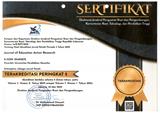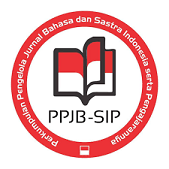PEMBELAJARAN MENULIS NASKAH DRAMA MELALUI PEMODELAN DI KELAS XI IPS MA SYAMSUL HUDA TEGALLINGGAH
DOI:
https://doi.org/10.23887/jjpbs.v3i1.5291Abstract
Penelitian deskriptif ini bertujuan mendeskripsikan (1) pembelajaran menulis naskah drama melalui pemodelan dan (2) hambatan-hambatan yang dihadapi oleh siswa dalam belajar menulis naskah drama melalui pemodelan. Subjek penelitian ini adalah siswa dan guru kelas XI IPS MA Syamsul Huda Tegallinggah. Pengumpulan data dalam penelitian ini menggunakan metode observasi, wawancara, dan dokumentasi. Data yang diperoleh melalui ketiga metode tersebut diolah melalui beberapa tahap, yaitu (1) reduksi data, (2) klasifikasi data, (3) penyajian data, dan (4) pengambilan kesimpulan. Hasil penelitian secara umum membuktikan bahwa pembelajaran menulis naskah drama melalui pemodelan pada siswa kelas XI IPS MA Syamsul Huda Tegallinggah sudah berhasil dengan baik. Hal ini terbukti dari hasil yang dicapai oleh siswa dalam pembelajaran menulis naskah drama melalui pemodelan. Empat kelompok sudah mencapai nilai di atas KKM. Dalam pembelajaran menulis naskah drama melalui pemodelan, guru menggunakan beberapa metode, yaitu metode ceramah, diskusi, tanya jawab, dan penugasan. Hambatan-hambatan yang dihadapi siswa ketika belajar menulis naskah drama melalui pemodelan adalah kekurangmampuan siswa memperagakan naskah drama dalam dialog dan kekurang mampuan siswa dalam menciptakan puncak atau klimaks mengenai permasalahan yang dihadapi. Penelitian ini bermanfaat untuk memberikan sumbangan konseptual pada pendidikan bahasa, khususnya, pembelajaran menulis naskah drama melalui pemodelan sebagai bentuk apresiasi terhadap karya sastra drama.Kata Kunci : pembelajaran menulis, naskah drama, pemodelan dalam drama
This descriptive study aims to describe (1) the learning playwriting through modeling and (2) the barriers faced by students in learning playwriting through modeling. The subjects were students and teachers in class XI IPS Syamsul Huda MA Tegallinggah. Collecting data in this study using observation, interviews, and documentation. The data obtained through these three methods is processed through several stages, namely (1) data reduction, (2) classification of data, (3) presentation of data, and (4) making the conclusion. General research results prove that learning playwriting through modeling in class XI IPS Syamsul Huda MA Tegallinggah been successful. This is evident from the results achieved by students in learning playwriting through modeling. Four groups had reached a value above the KKM. In learning playwriting through modeling, the teacher uses several methods, namely lectures, discussions, question and answer, and assignment. Barriers faced by students when studying playwriting through modeling is demonstrated incapacity student plays in the dialogue and lack of ability of students in creating a peak or climax of the problems faced. This study is useful to provide a conceptual contribution to the language education, in particular, learning playwriting through modeling as a token of appreciation for the literary works of drama.
keyword : learning writing, plays, modeling in drama
Published
2015-07-22
Issue
Section
Articles
License
Authors who publish with the Jurnal Pendidikan Bahasa dan Sastra Indonesia Undiksha agree to the following terms:- Authors retain copyright and grant the journal the right of first publication with the work simultaneously licensed under a Creative Commons Attribution License (CC BY-SA 4.0) that allows others to share the work with an acknowledgment of the work's authorship and initial publication in this journal
- Authors are able to enter into separate, additional contractual arrangements for the non-exclusive distribution of the journal's published version of the work (e.g., post it to an institutional repository or publish it in a book), with an acknowledgment of its initial publication in this journal.
- Authors are permitted and encouraged to post their work online (e.g., in institutional repositories or on their website) prior to and during the submission process, as it can lead to productive exchanges, as well as earlier and greater citation of published work. (See The Effect of Open Access)







